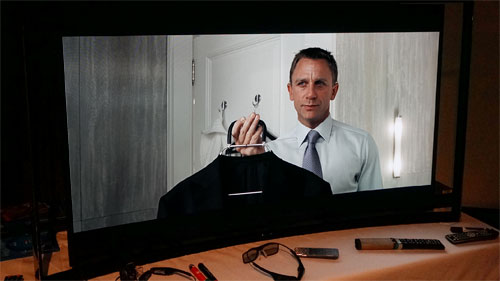OLED is seen as the perfect technology for TV displays. It produces fantastic images, the screens can be flexible and thin, and they’re very easy on power consumption. But building OLED displays is easier said than done, especially when we’re talking larger screens for TVs, which is why Samsung is trailing way behind cross-town arch rival LG Electronics in this emerging market.

But Samsung might just have found a solution in the form of an OLED startup called Kateeva. The Menlo Park, California-based firm has just nabbed a whopping $38 million in funding, with a chunk of that coming from the South Korean consumer electronics giant.
We’ve discussed Kateeva before. The startup has actually been around since 2008, but it wasn’t until last year it finally unveiled its revolutionary inkjet printing solution – called YIELDjet – which it claims can slash the costs of manufacturing OLED whilst simultaneously boosting production yields.
Current OLED manufacturing methods involve placing organic light-emitting diode materials in precise patterns on a substrate. Manufacturers typically use vapour deposition and shadow masks to create these patterns, usually on glass. The method is inefficient because the material that hits the glass is wasted, and it’s also difficult to make larger screens because the shadow masks aren’t stable enough to produce defect-free pixels in reliable numbers. The result is lots of defective panels produced at a very high cost, and that’s why large OLED televisions come with such eye-watering price tags.
Kateeva’s inkjet printing looks to be the most viable alternative, enabling “speed throughout the whole process, wonderful scalability, superb efficiency, and possibly better particle performance, too.”
The technique is somewhat difficult to master, but Kateeva says it’s ready to begin shipping manufacturing equipment by the end of the year, at least for smaller displays. As for large-screen manufacturing systems, these should be ready by early next year – which means Samsung may finally be ready for OLED prime-time.
Certainly it can’t come soon enough. So far, LG is the only television manufacturer with a viable OLED TV technology which effectively allowed it to corner the market. LG uses something called “white OLED technology” originally developed by Kodak, and currently claims 80 percent-plus yield rates. As a result, analysts are predicting LG will dominate the OLED market for the next few years at least, and the evidence is there for all to see, as it’s the only brand that’s actually released a new OLED TV this year.
But Samsung’s investment in Kateeva is a big vote of confidence in its technology, and could yet tilt the balance back in its favour. If they can get it right it’ll be worth every penny – Kateeva’s CEO Alain Harrus says the OLED market will be worth more than $1 billion annually by 2020.

Forget OLED. Due to fast degradation, 2.5x power consumption at the same brightness vs LCD, imprints, it’s another dead tech after plasma unless its production cost will be dirty cheap. It will never will be your computer screen though.
Now, that’s an unexpected turn of events. Samsung probably can chase LG, if the inkjet printing method is really effective.
i want 65″samsung oled but with good design , cause i don`t want to see kns9c again .
@s4h you are way off with your comments… power consumption is less than LCD, if by degrade you mean the blue light half life span ..then that was resolved by LG using white and Samsung by using a larger blue, …overall OLED uses the same manufacturing process (in fact it has less steps than LCD)….once yields have increased the price will drop…it is already happening if you compare the high prices last year with the latest OLEDs launched… this is not dead tech ….once they hit the right prices and they will …the market will adopt them as it is Superior to LCD…in the long term for TV manufactures it will be cheaper ( hence bigger profit) to make OLED TVs.
@Thomas
Don’t lose your common sense, for example in Samsung case larger blue does not fix the problem, it just align still relatively short degradation lifetime for all three colors.
Proof of my words is in non-existence of hi-end OLED monitors. Nothing was fixed, the life span was just extended from completely unacceptable still being not even close to the one of LED backlit LCDs. The numbers so far were in the range of 4000 hours for OLED. Even if this will be 10000 that is still 3 times short if LED LCD
I agree with s4h if OLED is not capable of providing adequate screen life span in comparison to existing technology the price will be irrelevant as the OLED market will suffer as a consequence of bad consumer reviews. The market always determines the adoption of technology not the manufacturers, the only proviso would be if commercial incentive was behind superseding a well established LED market to future proof OLED investment for the movie and entertainment industry especially with the potential of 4K video streaming.
I also agree with s4h.
LG lifespan is a marketing lie.
http://forums.hdtvtest.co.uk/index.php?topic=9227.0